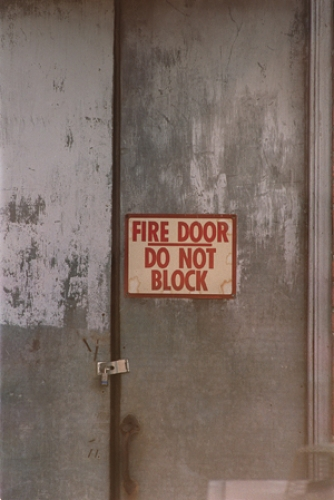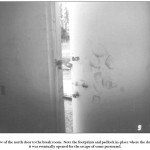 This week marks the 30th anniversary of a tragic fire at Imperial Food Products – a chicken processing plant – where 25 workers lost their lives. Egress doors in the plant had been padlocked to prevent employee theft, and when the fire occurred, many building occupants were unable to escape quickly. [Refer to my post about the 20th anniversary for more information about this fire.]
This week marks the 30th anniversary of a tragic fire at Imperial Food Products – a chicken processing plant – where 25 workers lost their lives. Egress doors in the plant had been padlocked to prevent employee theft, and when the fire occurred, many building occupants were unable to escape quickly. [Refer to my post about the 20th anniversary for more information about this fire.]
At the time of the fire, the necessary code requirements were in place to ensure free egress, and compliance could have saved dozens of lives. Padlocked egress doors were not allowed by code 30 years ago, and they are not code-compliant today. In almost all cases, egress doors must allow building occupants to exit without a key, tool, special knowledge, or effort, and with one motion to unlatch the door.
What contributed to the Imperial Food Products tragedy was the fact that state safety inspectors had never visited the building – in 11 years of operation. In addition, inspection reports showed that a USDA inspector responsible for overseeing the handling and processing of chicken, had approved the locking of an exit door to keep flies out of the building.
This led to a 1994 agreement between the U.S. Department of Labor Occupational Safety and Health Administration (OSHA) and the U.S. Department of Agriculture Food Safety and Inspection Service (USDA FSIS), which required USDA inspectors to be trained to report serious workplace hazards to OSHA. This makes a lot of sense because the USDA inspectors are often in these facilities daily. But according to an article in The Assembly, in the last 27 years there has been no evidence of the USDA forwarding a written notification about worker safety concerns to OSHA.
You can read the full article at theassemblync.com, but here is an excerpt:
At one federal agency, the lessons of Hamlet never took root.
While a state safety inspector had never visited the Imperial building, U.S. Department of Agriculture (USDA) food-safety inspectors were there every day to check on the quality of the chicken—and even approved locking a door to keep flies out. Politicians of both parties were aghast that a government inspector would endorse locking an exit door, which violated state and federal law.
USDA, which said it had no responsibility for workplace safety, relented under pressure. In early 1994, it signed an agreement saying its inspectors would be trained to report “serious workplace hazards affecting plant employees.” USDA inspectors were to report the hazards to their bosses, who would report them to the U.S. Occupational Safety and Health Administration (OSHA).
But that never happened. In the 27 years since the agreement was signed, The Assembly has found no evidence that USDA has ever forwarded a written complaint involving worker safety anywhere in the nation to OSHA.
One of the principal lessons of the Hamlet tragedy—that government inspectors of all types should be trained to recognize and report serious safety hazards—was largely disregarded.
Personally, I think cross-training of inspectors could vastly improve the safety of workers and other building occupants, but clearly the agreement between the USDA and OSHA did not have the intended results. What do you think? Should inspectors tasked with ensuring the safety of chicken processing, for example, be expected to report hazards in the workplace?
WWYD?
You need to login or register to bookmark/favorite this content.









Lori…. in my observations in the healthcare industry, cross training rarely works. When accreditation organizations tried to cross train medical, clinical, or even administrative surveyors to look for Life Safety Code violations it usually did not go well. They were looking for a certain type of violation and missed the obvious and low-hanging problems. I agree a locked egress door should be easy to see but in reality, the cross training rarely worked out. That’s why most (if not all) accreditation organizations now have LSC surveyors.
I hear you, Brad. But it seems too easy for people to overlook obvious hazards if they’re not being paid to address them.
– Lori
Whats good for the goose is good for the gander does not work for home and public places. So many people think what works at home will work at there place of business. I have been in the automotive end and am new to the door lock end,and I see LOTS of hasps and padlocks on doors. small mom and pops are the worst. Maybe a law could be written like the child abuse that requires you to report
PADLOCKS SHOULD BE BANNED ON ALL DOORS.
I agree, Joe! Unfortunately, the codes don’t specifically say “NO PADLOCKS ALLOWED.”
– Lori
I think that given the fire history and there was a plan in place, if no one in the government who had the knowledge of the agreement acted they should lose their employment and someone should go to jail. That is exactly how I feel when authorities ignore the safety of those entrusted to their care. Call me old fashioned
The responsibility for a safe workplace should fall on the owners or executives in charge. They or their representatives are there every day. Inspectors are not.
OSHA is a joke to most owners or executives. OSHA fines for even fatalities are barely a slap on the wrist.
Most people do not recognize USDA inspectors are in a difficult situation trying to serve two masters… enforcing government standards while their paycheck and employment benefits actually come from the food company. Little wonder not a single report has been passed on in almost 30 years. However, I would prefer to see a food safety inspector to focus on what they are there to do. A food inspector should not have any authority to either approve or disapprove of changes to an exit as it is not in their realm of expertise or authority. Pretty much analogous to all of the police departments and security departments that make building security decisions that negatively impact egress and life safety… they might have good intentions but their true lack of knowledge and expertise is manifested when they fail to involve the fire department and building officials in the decision making process.
The fire door inspection program has been turned into a poor joke. DHI and ALOA and other industries that put forth training programs find that the initial graduates that were performing the inspections are now being replaced by “qualified” people now meaning that the replacements have to demonstrate that they know which end of a screwdriver to hold-maybe! Hospitals have left TJC behind tho find other venues that offer less stringent requirements. Where there are holes to wiggle out of the less costly paths are being chosen. PROFIT is still the bottom line and as stated cross training seldom works in TURF WARS.